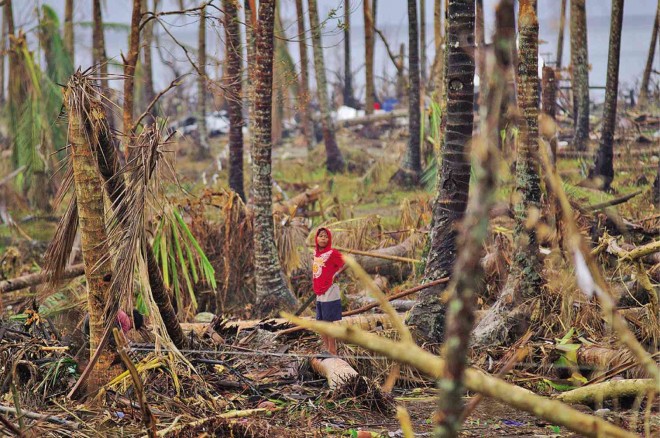The language of climate change

A boy explores a field of coconut trees, wrecked by winds brought about by Supertyphoon “Yolanda” (international name: Haiyan), in a rural community of Salcedo town in Eastern Samar province. RICHARD BALONGLONG
Global warming has become a catch-all phrase to explain everything that goes wrong in the environment these days, even among Filipinos, whether they live in urban centers or out in the farms or the hinterlands.
But while Filipinos have embraced the idea that climate change has refashioned the way they live, the risks attributed to extreme weather patterns have not been easy concepts to explain in this country.
For example, the Aquino administration now knows people did not understand “storm surge” well enough to fear its impact, so 6,268 people died and 1,061 people are still missing after Supertyphoon “Yolanda” (international name: Haiyan) swept through the Eastern Visayas region on Nov. 8, 2013.
During the International Conference on Building Resilience and Developing Sustainability that was held in Baguio City last week, social scientists from various countries and Philippine universities examined the government’s new catch phrases—“resilience” and “building back better”—which it uses to inspire communities to embrace disaster response protocols and to understand the dangers of “the new normal.”
They also found these phrases wanting. A Miriam College professor said popularizing “resilience” would make people believe that “disasters have now become acceptable.”
“The word ‘vulnerability’ is better,” said Dr. Dorothea Hilhorst, a professor of humanitarian aid and reconstruction at Wageningen University in The Netherlands.
“Resilience does not make us ask what caused the disaster. Resilience does not make us ask where risk comes from,” Hilhorst said when she and other scholars examined the gaps in understanding climate-related calamities.
Translation problem
Communication professor Jimmy Fong of the University of the Philippines Baguio described the difficulties of communicating risk to average Filipinos as a translation problem.
For these catch phrases and concepts to be self-explanatory enough to push people to move to safer grounds, Fong said, policy-makers must bridge “the culture and language of the scientific community or experts, and the culture and language of ordinary but vulnerable people who are at the receiving end of disaster and risk situations.”
“Most of the communications about environmental issues come from the science community or culture with its own scientific or technical language,” he said.
But there is growing evidence that simply transmitting “translated” knowledge may not be efficient, said Hideyuki Shiroshita, an assistant professor for the faculty of safety science in Japan’s Kansai University.
Shiroshita said Japan’s education system has embraced disaster risk information, since his country developed a curriculum on disaster in the 1990s following the 1995 Kobe earthquake.
But when the Tohuko earthquake and tsunami struck in 2011, only 2.5 percent of the population evacuated in response to Japanese government warnings, he said.
Although empowered by knowledge, people’s behavior did not change, he said. For many Japanese, he said, disaster education has become “too much of a bother.”
“Many people have [a] basic idea [of] how to [manage disasters or evade disasters] but people simply do not,” he said.
Disaster co-learning
He proposed a concept called disaster co-learning, after realizing that the Japanese rely completely on experts to handle problems or feel unappreciated by scholars when they devise their own ideas about protecting people from disasters.
Shiroshita applied this concept at a Japanese high school recently. He promoted a mapping application which allowed teenagers to study their locality and draw up rescue or evacuation plans should disasters strike.
Both the Philippine government and its scholars are headed in this direction. Fong said the government’s disaster risk management program takes into account indigenous peoples’ knowledge as a source of information to help understand how local communities appreciate the impact of a changing climate.
But the idea of achieving a common understanding about climate change is much more complex, Hilhorst said.
Choosing one risk over others
“People often choose particular risks over others,” she said, adding that this defines how communities and governments prepare for disasters, no matter how well-informed.
For example, she said, the Mozambique government in Africa once tried hard to relocate a community from a flood-prone area but had failed, so it “withdrew all services … no schools, no hospitals, to force people out.”
“But people do not like to be displaced,” she said. “In Mozambique, people [affected seasonally by floods] appreciated [the risks] differently and they wanted flexibility….
Between the floods, they preferred to return to their houses to do fishing and agriculture.”
Hilhorst said most communities tend to dismiss calamities that affect them regularly. “When something [that ravages communities] is defined as a new phenomenon, people tend to consider it as a bigger risk rather than the calamities we receive on a regular basis.”
“A plane crash attracts more attention than car accidents, even if more people are killed by vehicles when these cases are all added up,” she said.
To get local people to make disaster risk management part of their lifestyles, they need “to know who classifies risk, who determines responsibilities, who pays for risk and who does not pay for risks, who determines the solutions and what are the unintended consequences,” Hilhorst said.
People also need to remember. “Make sure that stories keep coming out … following what happened to the disaster victims in the Philippines. We don’t know what happens to these people because we are already looking at the next disaster,” she said.














